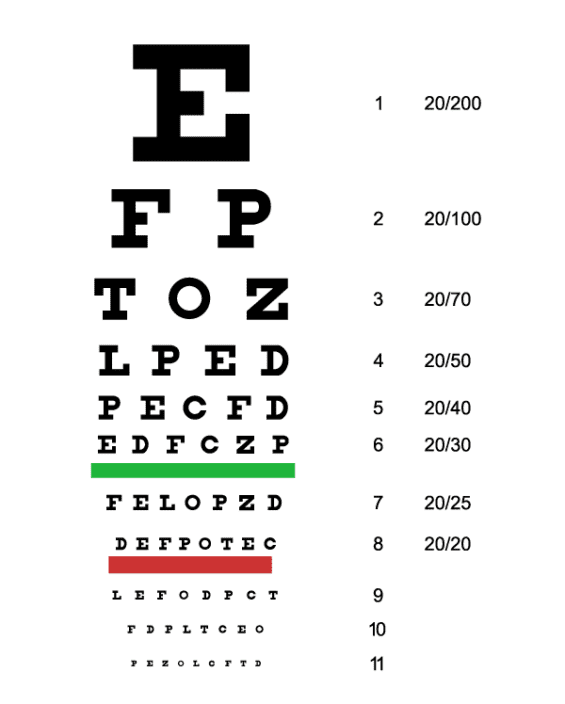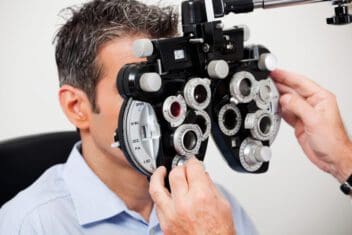Visual Acuity: Testing (From Home), Definition & More
Home / Vision Education Center /
Last Updated:
Visual acuity is a measurement of how clear your vision is, typically using a Snellen Chart, at about 20 feet or 6 meters. While visual acuity is not the only way to determine how healthy your sight is, it is an easy way to understand if you have a refractive error or if your sight is changing.
You can test at home, but it’s a good idea to get an official test from a vision professional.
Getting regular eye exams as often as needed is the best way to keep your eyes healthy. In an exam, an optometrist or ophthalmologist will measure more than just the clarity of your sight.
Table of Contents

What Is Visual Acuity?
Visual acuity refers to how clear your vision is, based on measurements like the Snellen Chart. In the United States, visual acuity is measured at 20 feet.
Ideal visual acuity is 20/20 or being able to see objects clearly at 20 feet away. Acceptable visual acuity is 20/40 or being able to see objects that are 20 feet away as though they were 40 feet away. If you have 20/100 vision, you must be as close as 20 feet to see what the average person can see at 100 feet.
You deserve clear vision. We can help.
With 135+ locations and over 2.5 million procedures performed, our board-certified eye surgeons deliver results you can trust. Your journey to better vision starts here.
While this measurement is consistently used to determine your refractive error (nearsightedness, farsightedness, or astigmatism), it is not the only measurement of good vision. It simply indicates the sharpness of your vision at certain distances. This is important for basic tasks like driving or reading.

Other important factors in your vision are color vision, focusing ability, eye coordination, depth perception, and peripheral awareness, which are not measured by visual acuity.
If you struggle with blurry or double vision, either up close or far away, you may be concerned about deteriorating visual acuity. Getting help from an optometrist or ophthalmologist will ensure you know what your visual acuity is and can get a prescription to correct any issues. You can also test your visual acuity at home if you are curious about your eyesight.
Can You Test Your Visual Acuity at Home?
Visual acuity testing with a Snellen Chart, the famous chart starting with a large E and decreasing in size, can be used to test the clarity of your eyesight. Schools, offices, and community service organizations may all offer basic visual acuity testing to see if you need further vision tests.
The Snellen Chart is one among several ways that optometrists and ophthalmologists assess your potential refractive error, so they can examine you further for glasses or contact lenses. They may also determine you need your pupils dilated or retina examined, which can help them see if there are underlying causes for poor visual acuity.
You can do testing at home with your friends and family by setting up a Snellen Chart, but it is important to remember that this is not a substitute for a thorough eye exam conducted by an eye doctor. If you think you have a vision problem, your child has a refractive error, or you just want to test yourself for fun, visual acuity tests are available.

To test yourself at home, you need:
- A printable Snellen Chart, which you can download online.
- Something to cover one eye at a time, like an eye patch or a paper cup.
- Scissors.
- Tape or tack to hang the chart on your wall.
- Pencil or pen to record your results.
- Yardstick, tape measure, or ruler to determine how close you are to the chart.
- A flashlight.
- A well-lit room that is at least 10 feet long.
Have the person you are testing sit in a chair at least 10 feet away from the chart. You may darken the room and use the flashlight to illuminate the row you want your test subject to read, but this is not necessary.
Get your subject to cover one of their eyes. They may choose to remove their glasses or contact lenses if they want to test their basic visual acuity, but you can also test their visual acuity with prescription eyewear in place.
Point toward a line on the chart and ask your subject to read it. Start with some larger letters, but keep track of the lines they read correctly compared to the lines they cannot see well. Record the smallest line they can see. Repeat the test with the other eye covered. Many people have different prescription strengths in each eye.
Regular Testing With Optometrists or Ophthalmologists Keeps Your Eyes Healthy
Only about 35 percent of American adults have 20/20 vision without the assistance of glasses, contact lenses, or refractive surgery. Thanks to corrected vision, about three-quarters of adults have 20/20 vision.

Some people have vision that is better than 20/20. If you have 20/15 vision or higher, it means you can see more clearly than average visual clarity. You only need 20/40 vision, either corrected or uncorrected, to obtain a driver’s license.
It is important to get your vision tested regularly, and these recommendations differ by age.
- Children: From birth to 2 years old, children should get eye exams every six months if they have healthy eyes. From 3 to 5 years old, they should get an eye exam at least once. Adolescents who are between 6 and 17 years old should get annual eye exams or on a schedule that is recommended by their pediatric optometrist.
- Young adults: From 18 to 39 years old, you should get your eyes examined at least every two years to ensure there are no underlying issues that develop. If you have a consistently progressing refractive error like nearsightedness or farsightedness, you may need to be tested more often.
- Middle-aged adults: From 40 to 64 years old, you should get your eyes tested at least every two years, unless your eye doctor recommends more frequent testing.
- 65 and older: You should get your eyes tested every year unless you have a medical condition that requires more frequent testing.
These comprehensive eye exams typically include use of a Snellen Chart, but you may also have your pupils dilated, have dyes used to test blood vessels in your eyes, or have your fluid pressure tested. These are all vital tests for your eye doctor to understand how healthy your vision is.
Skipping these routine examinations and testing at home will not get you the treatment you might need or keep your prescriptions updated. Home testing can help you understand if you have a problem with your visual acuity and if it is progressing. If you notice a problem at home, it’s time to see a professional.
You deserve clear vision. We can help.
With 135+ locations and over 2.5 million procedures performed, our board-certified eye surgeons deliver results you can trust. Your journey to better vision starts here.
References
- Visual Acuity: What Is 20/20 Vision? American Optometric Association (AOA).
- Visual Acuity Test. (February 2020). MedlinePlus.
- Home Eye Test for Children and Adults. (December 2016). American Academy of Ophthalmology (AAO).
- 50 Printable Eye Test Charts. (May 2017). Printable Templates.
- What Does 20/20 Vision Mean? (January 2020). American Academy of Ophthalmology (AAO).
- Recommended Eye Examination Frequency for Pediatric Patients and Adults. American Optometric Association (AOA).
This content is for informational purposes only. It may have been reviewed by a licensed physician, but is not intended to serve as a substitute for professional medical advice. Always consult your healthcare provider with any health concerns. For more, read our Privacy Policy and Editorial Policy.